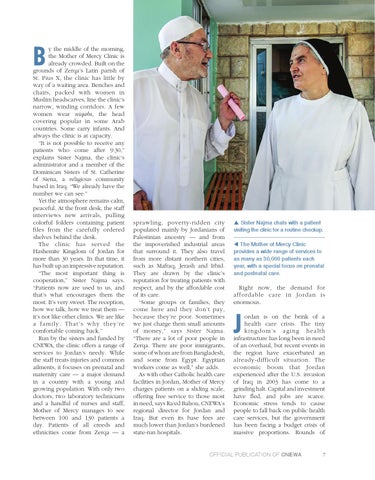B
y the middle of the morning, the Mother of Mercy Clinic is already crowded. Built on the grounds of Zerqa’s Latin parish of St. Pius X, the clinic has little by way of a waiting area. Benches and chairs, packed with women in Muslim headscarves, line the clinic’s narrow, winding corridors. A few women wear niqabs, the head covering popular in some Arab countries. Some carry infants. And always the clinic is at capacity. “It is not possible to receive any patients who come after 9:30,” explains Sister Najma, the clinic’s administrator and a member of the Dominican Sisters of St. Catherine of Siena, a religious community based in Iraq. “We already have the number we can see.” Yet the atmosphere remains calm, peaceful. At the front desk, the staff interviews new arrivals, pulling colorful folders containing patient files from the carefully ordered shelves behind the desk. The clinic has served the Hashemite Kingdom of Jordan for more than 30 years. In that time, it has built up an impressive reputation. “The most important thing is cooperation,” Sister Najma says. “Patients now are used to us, and that’s what encourages them the most. It’s very sweet. The reception, how we talk, how we treat them — it’s not like other clinics. We are like a f ami l y. Th a t’s w hy t hey’r e comfortable coming back.” Run by the sisters and funded by CNEWA, the clinic offers a range of services to Jordan’s needy. While the staff treats injuries and common ailments, it focuses on prenatal and maternity care — a major demand in a country with a young and growing population. With only two doctors, two laboratory technicians and a handful of nurses and staff, Mother of Mercy manages to see between 100 and 130 patients a day. Patients of all creeds and ethnicities come from Zerqa — a
sprawling, poverty-ridden city populated mainly by Jordanians of Palestinian ancestry — and from the impoverished industrial areas that surround it. They also travel from more distant northern cities, such as Mafraq, Jerash and Irbid. They are drawn by the clinic’s reputation for treating patients with respect, and by the affordable cost of its care. “Some groups or families, they come here and they don’t pay, because they’re poor. Sometimes we just charge them small amounts of money,” says Sister Najma. “There are a lot of poor people in Zerqa. There are poor immigrants, some of whom are from Bangladesh, and some from Egypt. Egyptian workers come as well,” she adds. As with other Catholic health care facilities in Jordan, Mother of Mercy charges patients on a sliding scale, offering free service to those most in need, says Ra’ed Bahou, CNEWA’s regional director for Jordan and Iraq. But even its base fees are much lower than Jordan’s burdened state-run hospitals.
p Sister Najma chats with a patient visiting the clinic for a routine checkup. t The Mother of Mercy Clinic provides a wide range of services to as many as 30,000 patients each year, with a special focus on prenatal and postnatal care.
Right now, the demand for affordable care in Jordan is enormous.
J
ordan is on the brink of a health care crisis. The tiny k in g d o m ’ s ag in g h ea l t h infrastructure has long been in need of an overhaul, but recent events in the region have exacerbated an already-difficult situation. The economic boom that Jordan experienced after the U.S. invasion of Iraq in 2003 has come to a grinding halt. Capital and investment have fled, and jobs are scarce. Economic stress tends to cause people to fall back on public health care services, but the government has been facing a budget crisis of massive proportions. Rounds of
OFFICIAL PUBLICATION OF CNEWA
7
